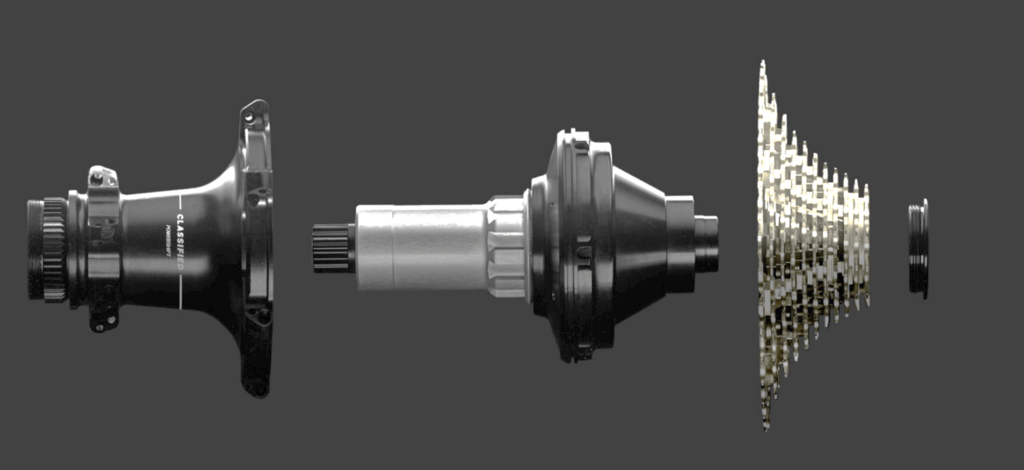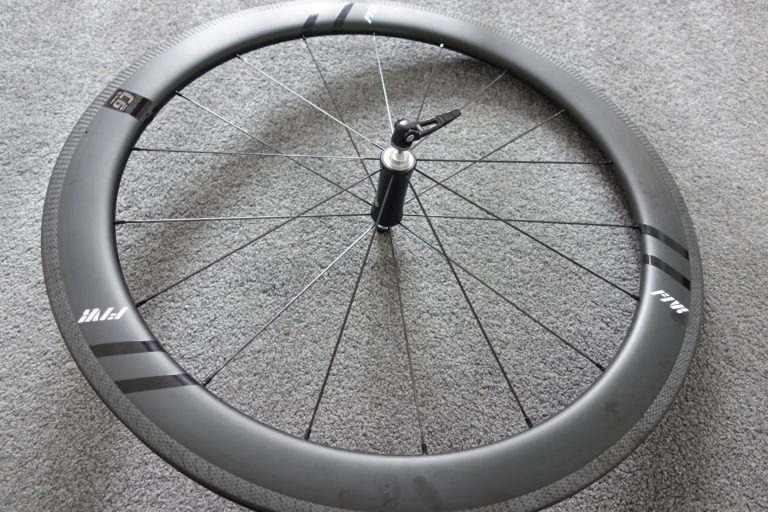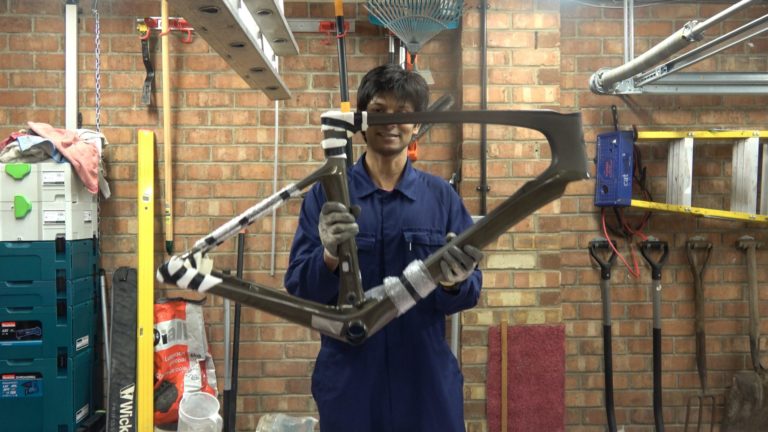Classified Powershift Hub System: Technical Analysis

Introduction
The classified hub system for a bike is a type of gear hub that allows for multiple gear ratios to be achieved without using a traditional derailleur system. This system was released onto the market last year and was described as a game changer. It is extremely expensive compared to a 2x setup. Parcours retails the Classified Powershift at £1329, which is well over half the cost of some electronic groupsets.

Technical Details
The hub contains an epicyclic (planetary) gearbox that allows two ratios to be selected, an electronic slave unit is encompassed in the rear wheel hub assembly, and mechanical components are predominantly housed in the area where the freehub would be positioned on a more traditional setup.
The two ratios that can be selected are fully locked, providing direct power from the chainrings through to the wheels or in step down where speed reduction occurs inside the gearbox, the reduction ratio is about 0.7. Hence for a 52 teeth chainring, the virtual small chainring would be 36 teeth.
Epicyclic gearboxes using the configuration that Classified has deployed can have four possible combinations. They are shown below for completeness
It is likely that gear combinations 2 and 4 are used. Gear combination 4 is fully locked. Gear combination 2 is the step-down ratio. In this combination, power is taken from the outer ring and transferred to the planetary gears which have a universal carrier that links them together, the power is taken from this carrier. There is considerable friction generated from multiple spur teeth interfaces and friction on the carrier pins. There will also be a hydraulic loss from the shearing of any grease inside the unit.
Power Train Losses
The epicyclic gear of the classified hub is effectively a compound gear so its efficiency is multiplied with that of the conventional chain and sprocket to transfer power from the chainrings to the back wheel.

\begin{equation} G_{total} = G_{1} \cdot G_{2} \end{equation} \begin{equation} G_{total} = 97\% \cdot 96\% =93.1\% \end{equation} The net result is an efficiency of around 96% (optimistic guess for the classified hub) and a total deficit of 4% vs a 2X conventional setup in low gears (93.1% vs 97%). Many people familiar with epicyclic gearboxes think that is an optimistic amount and suggest the efficiency of the gearbox alone would be around 90%. That would equate to a 2X drivetrain at around 97% efficiency and the classified system at around 87% system efficiency. Losses have been suggested at the high levels of sealing required to stop dirt ingress, the friction generated from the numerous gears which appear to be bushed and pin losses. This paper was highlighted by a few of the respondees.

Manufacturing
The classified hub appears to be predominantly of aluminium in manufacture. It’s highly likely to be 7000 series. The internal gears appear to be brass or bronze. It’s worth noting that the planetary gears appear to be held on pins that look too large to accommodate a bearing. There appear to be six planetary gears on a carrier.
The sun wheel or gear is located in the centre and there is some evidence that this is locked. The manual points to a counter torque bar (item 3b) which takes its reference force from the disc brake mount. This could make installation on some bike frames difficult.

Cassette
The cassette on the Classified hub is a proprietary part and is inherently expensive to manufacture, it is believed these are made by Recon. The load on most cassettes is transmitted on each sprocket by way of splines to the hub, and many budget hubs are stamped pieces of metal with some post-machining and forming. On the Classified hub, the cassette is machined as one piece; the drive looks to be located on the outer periphery towards the larger sprockets. There would be an amount of torque wind up on the smaller sprockets. It is unclear if this would be significant.


Wheel Partners
The Classified website lists many wheel suppliers as partners of the project and will supply wheels with hubs suited for Classified hubs. It is worth noting the electronics, gears and actuation would not be supplied in most of these instances. The supply would consist of the flanged hub connected via spokes. It’s arguably much cheaper for the wheel suppliers to go down this route than to supply a traditional assembly with a freehub.

Overall
As a piece of engineering, the amount of effort that has gone into engineering the system into such a small space is noteworthy, but the commercial and technical hurdles for Classified to overcome are still plentiful. The cost and apparent performance deficit (some commentators have guessed at 10%) may be too much for a keen road cyclist to stomach.
Some ergonomic difficulties may prove to be the bigger hurdle. Riders have become accustomed to total integration at the brake hoods. Currently, a separate switch mounted onto the bars facilitates actuation. For true market penetration, it’s likely one of the groupset manufacturers will have to take a vested interest or provide full integration.
Watch on YouTube
Disclaimer
It should be noted that Classified was approached to provide a sample for review and power testing, that request was ignored and thus, the data used in this article was obtained from open sources.







I looked into this system as well and arrived at the same conclusion. To make matters worse:
– the reliability is completely unproven (the site claims longer then other internal parts of the bike, which is the most ambiguous statement of reliability ever).
– The shifting under full load is a BS argument, you will either just come to a standstill or go over the bar when the pedals sink below your feed.
– The claims about chain tension are valid in theory, but really depend on the setup. This is probably the main reason victor campenaerts was riding a 1x setup with a 58 pasta plate on the front. You can’t get this at your local bike shop. Using a “standard” 1x setup with a 46 orso is just less efficient over the complete range.
The biggest nail in the coffin for investors/ambassadors in my opinion is:
– Shimano introduced the 8-11 speed alfine hub Di2 compatible in 2012, which basically uses the same gearing/technique. This leaves me to believe that the IP on this system is weak at best and if it would ever catch-on, the engineers at shimano would redesign this is about a month.
I think his pasta plate was a 62!
Tried to find the weight of this thing somewhere. Looks of marketing-speak BS but they just can’t say the thing weighs X grams? What are they trying to hide? Wonder how it compares to https://www.sturmey-archer.com/en/products/detail/cs-rk3-silver and who is gonna pony-up the loot for this? The guy who puts snake oil/wax on his chain to save a few watts ain’t gonna be happy with the watts wasted by this gizmo, no matter how great (investor)Tom Boonen claims it is. Their biz model looks like a classic way to make a small fortune – by starting with a large one!
The resemblence to the stumry archer is not lost!
It makes no sense to integrate this into the rear hub. The same planetary gearing solution would logically be better implemented at the crankset/bottom bracket. There is more room to put in the mechanism and all bikes already have the required setup to turn it on & off – using the existing cable stops and current FD brifter function as a switch. So no OEM support would be required for the idea to take off. Logically I find it amusing someone would spend significant expenses developing this unit without having evaluated the above.
The scientific evidence is different: more than 99% efficiency! https://acrobat.adobe.com/id/urn:aaid:sc:EU:5ee3cef7-159d-43a1-858f-2a34766ffc9d
Call me a cynic but my bottom bracket with two bearings and not much else would struggle to get to 99% efficiency. The classified unit has multiple tiny bearings, gears and plenty of frictional seals and it claims 99% efficiency.
You should not be cynic, you should be scientific and proof that hey are wrong by publishing a paper that rejects their claims…
A white paper over the efficiency claims of this does not really take my fancy. If you read through the dialogue of this, they were asked to provide a hub for checks, they decided not to so I had to draw my own conclusions.
In fairness, they have since said they would provide me a hub but owing to time constraints I have not taken them up on this. I would struggle to find a suitable piece of test equipment for a reasonable cost that could prove or not prove the results.
However, parking that to one side, if you go to engineering class 101 and ask them to find a machine with 99% efficiency with this many moving parts – they would roll their eyes, which is exactly why I have my comments. If they have 99% efficiency, then well done to them. But I’ll continue to be a sceptic until someone (other than me) does some independent testing. Peak Torque did a test but I don’t think it’s accurate enough.